E-Credit Trading: A Screen-Based Future?
Abstract
?
Celent predicts that approximately half of all credit index trades will be placed electronically by 2007, but that credit default swaps will not be traded electronically to a significant degree until at least the early part of 2006.
 As the credit derivatives market continues to grow exponentially, its participants are gradually migrating toward an electronic model. Dealers have indicated a willingness to place trades electronically, and clients are likely to do so starting in 2005. One inter-dealer broker has launched a popular electronic platform, and others are likely to follow. In a new report, ?,Celent examines the potential for different credit derivatives products to be traded electronically, and what this will mean for market participants such as exchanges and inter-dealer brokers.
As the credit derivatives market continues to grow exponentially, its participants are gradually migrating toward an electronic model. Dealers have indicated a willingness to place trades electronically, and clients are likely to do so starting in 2005. One inter-dealer broker has launched a popular electronic platform, and others are likely to follow. In a new report, ?,Celent examines the potential for different credit derivatives products to be traded electronically, and what this will mean for market participants such as exchanges and inter-dealer brokers.
The market is rapidly becoming standardized and automated. The ISDA has produced standard documents that market participants can use for their deals and recommended standard processes, such as the quarterly settlement of transactions. It has also set a number of ambitious deadlines for 2005 with regard to automation that appear likely to be met. "As standardization leads to increased liquidity, the major dealers will eventually build pricing engines and links to the relevant inter-dealer brokers and exchanges, which will truly facilitate widespread electronic trading," says Adam Josephson, analyst in the securities and investments group at Celent and author of the report. "The market has yet to reach the stage at which this is a necessity."
Approximately 25 percent of all trades of credit indices are now placed electronically, and that number will approach 50 percent by 2007, but at least a year will pass before the infrastructure will be in place for credit derivatives to be traded electronically on a large scale. Credit default swaps will not be traded electronically to a significant degree until at least the early part of 2006, when they will be sufficiently standardized and liquid.
The credit derivatives will follow in the footsteps of other fixed income markets. In the late 1990s, many thought technology would create a revolution in fixed income trading. Fixed income markets have been electronic for five years or so, and at most there is 10 to 15 percent electronic penetration, with plenty of room for growth. By the end of the decade, the credit derivatives market will likely be where most fixed income markets are now.
A
Table of contents is available online.of Celent Communications' Institutional Securities & Investments research service can download the report electronically by clicking on the icon to the left. Non-members should contact info@celent.com for more information.
|

